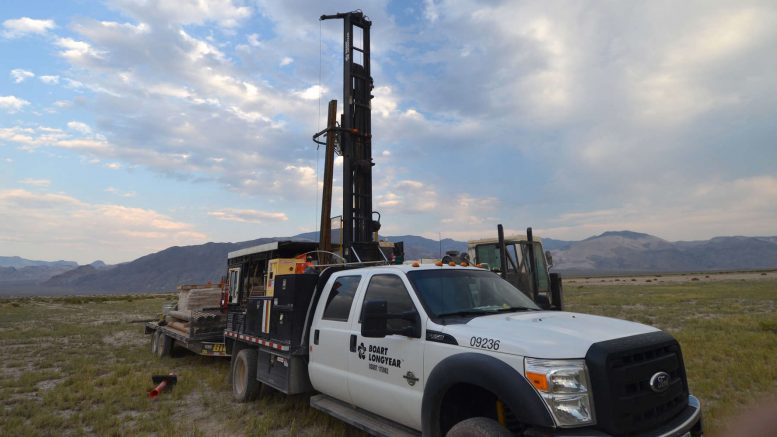American Lithium (TSXV: LI; US-OTC: LIACF) is about to drill its 6.3 sq. km Tonopah lithium claystone (TLC) project near Tonopah, Nevada.
Over the next six weeks the company will drill 1,600 metres across 10 to 20 holes. It will average 100-metre depths, drilling up to 160 metres below surface.
The company had previously collected 22 grab samples at TLC that graded as high as 1,380 parts per million (ppm) lithium and averaged 656.5 ppm lithium. It has found lithium mineralization across 5 sq. km at TLC, and says it appears to extend in all directions. It intends to determine the thickness of those claystone beds with its forthcoming drill program.
At the same time, American Lithium will continue lab work on leaching lithium from the project’s claystones.
“You know when you go looking for a gold resource that’s a gram or half a gram … that leaching technology works,” American Lithium director Andrew Bowering says in an interview with The Northern Miner. “There are proven technologies that work to leach gold out.

American Lithium’s TLC lithium claystone project in Nevada. Credit: American Lithium.
“We don’t necessarily know that yet with lithium 100%. There are companies getting close, but nobody has actually produced a successfully operating lithium plant yet to leach lithium from claystones.
“Ioneer [ASX: INR] is close, Lithium Americas [TSX: LAC; NYSE: LAC] thinks that Thacker Pass works, but until someone builds a mine and works all the bugs out of it and tweaks it to operate and generates a profit, you really don’t know.”
The company recently ran hydrometallurgical tests on samples from TLC that show the company can leach lithium from the project’s claystones with “increased extraction relative to immersion time.”
The company leach-tested seven samples from TLC with a mixed concentrate extraction, starting with a one-hour agitation in purified water and progressing to six- and 24-hour agitations in up to 20% sulphuric acid solutions. The company says lithium extraction increased progressively. The company is still running extraction tests at both its TLC and FLV lithium projects, and expects to announce results in early 2019.
“Comparative to it would be the 60s, with heap-leaching gold,” Bowering continues. “There was all this low-grade gold in Nevada that no one ever thought about or did anything with. Gold was only mined in high-grade situations. And then there was the advent of heap-leach technology, and the next thing you know, you’re mining 1 gram gold. We think the same thing can happen with lithium.”
After drilling its TLC project, the company will drill its 97 sq. km FLV lithium project. FLV is 2.6 km west of Ioneer’s Rhyolite Ridge lithium claystone project, which is undergoing a feasibility study.
According to a 2018 prefeasibility study, Rhyolite could produce 20,200 tonnes lithium carbonate per year over 30 years. The project has a US$1.8-billion, after-tax net present value at a 7% discount rate and a 28% after-tax internal rate of return, with payback in four years.
In late 2018, American Lithium ran 19 km of seismic surveys and gravity surveys, as well as delineation drilling and mapping at FLV that showed potential for claystone beds up to 200 metres thick.
Early work American Lithium completed at FLV focused on the west side of the property, close to Ioneer’s property. American Lithium has outcropping mineralization on that side of its property, but suspects the claystone beds there are relatively shallow. It also determined it doesn’t have a lot of room in that area to develop a resource.
“The assumption,” Bowering says, “is that the same rocks that are on the west side of the valley are also on the east side, and so we did some seismic lines across the valley going east–west, and some prospecting and mapping on the east side.
“What we have found is that the same package of rocks on the west side where Ioneer’s deposit is are also on the east side. We also think based on our seismic that there are thicker sequences on the east side.”
The company as a result applied for modifications to its permits that would allow it to drill those eastern targets.
In January 2019, the company added its first vanadium asset to its portfolio. The company will pay Nevada Alaska Mining US$100,000 and issue it 250,000 shares to earn a 100% interest in the Extinction Ridge vanadium project in Nevada, 30 miles north of Eureka and 55 miles south of Carlin. Assays from the vendor graded as high as 0.72% vanadium oxide, including a 30-metre trench at 0.46% vanadium oxide. The company acquired the project from the same vendor that sold it its lithium assets.
“There’s a little bit of snow there now, but we’re hoping by April it’s gone, and then we’ll go and do a little bit of surface work … some prospecting, surface mapping and some trenching,” Bowering says.
Shares of American Lithium are trading at 35¢ in a 52-week range of 22¢ to 74¢. The company has a $21-million market capitalization.


Be the first to comment on "American Lithium drilling Nevada claystones"